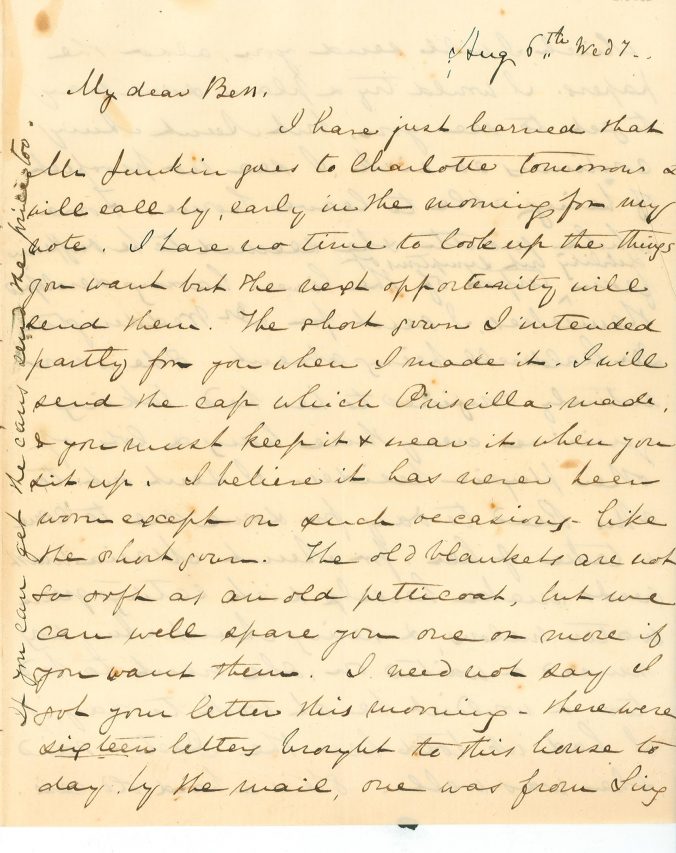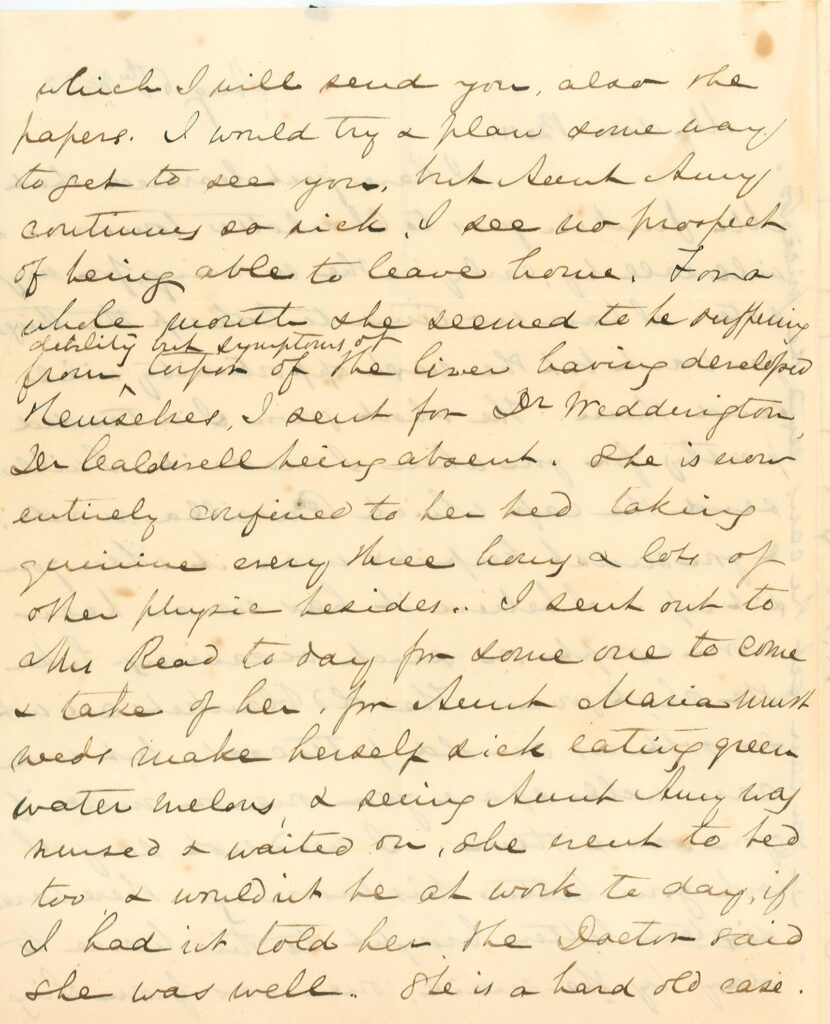This post was written by Alice Garner, a member of the Class of 2024, for an assignment in Dr. Devyn Spence Benson’s AFR 101: Introduction to Africana Studies class. For the past five years, the Africana Studies Department has collaborated with Davidson College Archives, Special Collections and Community to uncover the experiences of Black individuals at the college. Garner is an intended Psychology Major and possible Latin American Studies minor from Norwich, Vermont. Her interests include the intersection between the African diaspora and Latin American history and childhood developmental psychology.
Mary Lacy’s letters demonstrate her extreme ignorance as well towards blacks as a whole. Lacy reveals her husband’s utter exhaustion to “living in this country,” as he must complete tasks, such as making fires and feeding the animals, unsuitable to his high ranking position as President of the college.[1] She expresses that they “must conform to the ways of the people and buy [their] own servants,” a job that proves to be much harder than it appears to the Lacy family, despite serving as a ‘necessity’ in their privileged eyes.[2] On August 6, 1856, Lacy’s referral to her family friend’s plantation as a “favorite resort of Davidson professors and Davidson students” further establishes her dehumanizing angle towards those who work for her and her ignorance of the atrocious acts on the plantation.[3] In February of 1859, Lacy described an ‘incident’ in which a Davidson student’s belongings were stolen. A black man was whipped for this, despite “confess[ing] nothing” and another for merely “having a pistol.”[4] Lacy flits by this fallible case, stopping only to highlight how “poor Barry never got back his things.”[5] Lacy’s lack of acknowledgement towards the central issue of blatant racism shows her utter disrespect towards black people. The way in which Mary Lacy, wife to the former President at Davidson, glossed over such events raises a critical issue of the absence of general education and respect at the college towards human beings as a whole.

Page 1 of August 6, 1856 Letter 
Page 2 of August 6, 1856 Letter
The vast difference in Lacy’s treatment towards her own children in comparison to those enslaved serves as evidence towards her sole focus on being the quintessential wife of a slave-holder. In her letter on August 6, 1856, she expressed desperation as one of her slaves fell ill: “Aunt Maria must needs make herself sick….she is a hard old case.”[6] In choosing the word “must needs,” Lacy called Maria out, turning the slave into the one culpable for being sick, making the bourgeois life even harder. Lacy even went to question if her slaves were actually ill, denying them right to a doctor, claiming that her “black baby” was “getting well without any doctor.”[7] In reality, it was common for slaves to suffer “internal conflict and stress” due to long hours they were subjected to in the household.[8] Lacy’s interactions with her own children described as “fractious” vastly differed to those with the slaves who were chastised for no valid reason.[9] Lacy paid no mind to her young kids who would “keep [her] busy [trying] to keep them from killing each other.”[10] Lacy’s differences in reaction to when her slaves fell ill, compared to when her own children acted out, highlights her dependence upon slaves to provide her a path to be a proper slave-holding wife.
[1] Carlina Green et. al, “January 2, 1857.” Mary Lacy Letters (Davidson: WordPress, 2017).
[2] Ibid.
[3] Carlina Green et. al, “August 6, 1856.” Mary Lacy Letters (Davidson: WordPress, 2017).
[4] Carlina Green et. al, “February, 1859.” Mary Lacy Letters (Davidson: WordPress, 2017).
[5] Carlina Green et. al, “February, 1859.” Mary Lacy Letters (Davidson: WordPress, 2017).
[6] Carlina Green et. al, “August 6, 1856.” Mary Lacy Letters (Davidson: WordPress, 2017).
[7] Carlina Green et. al, “July 15, 1859.” Mary Lacy Letters (Davidson: WordPress, 2017).
[8] Jacqueline Jones, Labor of Love, Labor of Sorrow: Black Women, Work, and the Family, from Slavery to the Present (New York: Basic Books, 2009), 111.
[9] Carlina Green et. al, “July 2, 1856.” Mary Lacy Letters (Davidson: WordPress, 2017).
[10] Ibid.
This is the second post in a three-part series about Mary Lacy, the wife of Drury Lacy, the third President of Davidson College. In our collection, we are fortunate to retain a collection of Lacy Family Papers, which includes correspondence from Mary Lacy to her step-daughter Bess. In Spring 2017, Dr. Rose Stremlau’s History 306: “Women and Gender in U.S. History to 1870” class transcribed, annotated, and analyzed these letters. Their work can be found on this website. To view digitized items from the Lacy Family Papers, please explore Digital Davidson, our platform to view born-digital and digitized versions of archival materials, special collections, and college scholarship.

Speak Your Mind